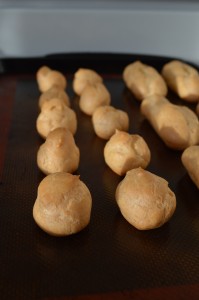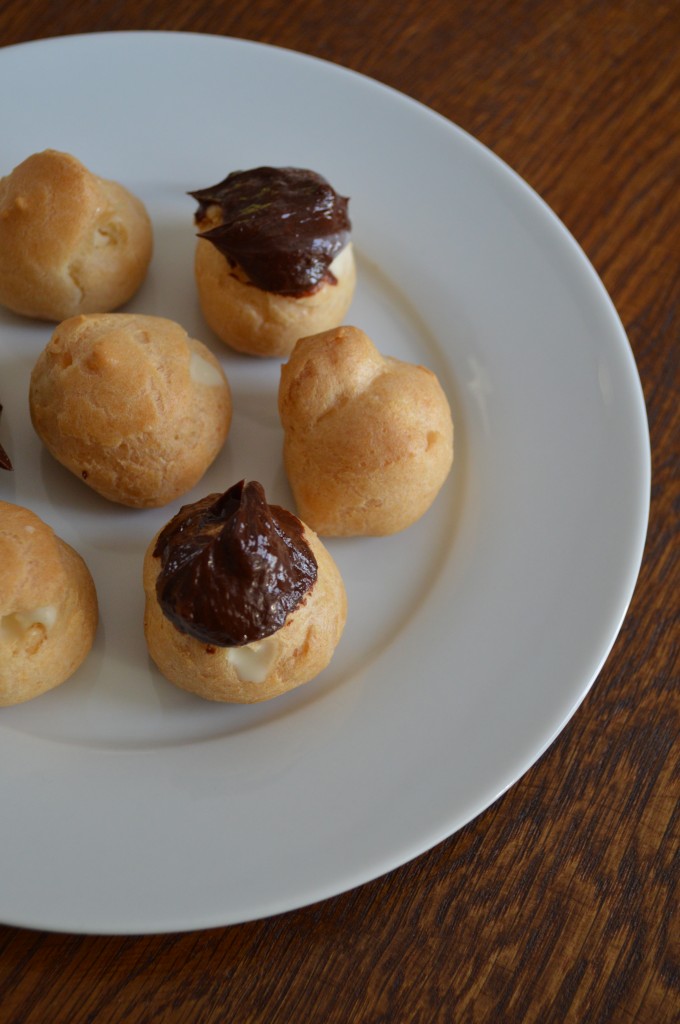 Before the exciting conclusion of Custard Week, I want to take you on a quick detour to show you some applications for the custards we’ve been making. Let’s talk about choux pastry.
Before the exciting conclusion of Custard Week, I want to take you on a quick detour to show you some applications for the custards we’ve been making. Let’s talk about choux pastry.
Choux pastry is a bit weird. First of all it’s weird because it’s not clear whether it’s a dough or a batter. Next it’s weird because it’s cooked twice, once on the stove, and once in the oven. Then it’s weird because when you cook it the second time it puffs itself up so that it’s entirely hollow. And finally it’s weird because its name is French for “cabbage pastry”. To my knowledge it is never eaten with cabbage, so I’m thinking that the name refers to the bubbly sphere a dollop of choux pastry forms when baked for the second time. I guess to French eyes this sphere looks like a cabbage. To me it looks like a baseball. That’s what’s funny about Europe: the little differences.
While the process for making choux pastry is bizarre, it is really easy. First you heat water and butter on the stove until the butter has melted. Then you whisk in some flour to make a paste. Stir this mixture over medium heat for a few minutes to cook out the starch.
 Then you remove the paste from the heat and let it cool down a bit. You do this because you’re about to add eggs, and you don’t want to cook the eggs quite yet: you just want to mix them into the batter, or dough, or whatever. Once the batter has cooled enough that you can comfortably stick your finger in it for more than a few seconds, you add the eggs, one at a time, while beating the hell out of the paste. At first it will seem that the batter won’t accept your eggs, but it will – just keep beating.
Then you remove the paste from the heat and let it cool down a bit. You do this because you’re about to add eggs, and you don’t want to cook the eggs quite yet: you just want to mix them into the batter, or dough, or whatever. Once the batter has cooled enough that you can comfortably stick your finger in it for more than a few seconds, you add the eggs, one at a time, while beating the hell out of the paste. At first it will seem that the batter won’t accept your eggs, but it will – just keep beating.
Once all your eggs are incorporated, the batter is done. You can pipe it immediately, or store it in the fridge.
There are several classic preparations made from choux pastry. As you can imagine, it lends itself well to being filled, as with profiteroles and éclairs.
In other applications it is left hollow: gougères, for instance, which are small, cheese-flavoured pastries, or gnocchis à la parisienne, which is deep-fried choux pastry.
For most applications choux pastry is baked in the oven. This is usually done in two stages: a high-temp baking around 425°F that rapidly vaporizes the water content so that the pastry can puff up before the starch sets, and a 350°F stage that sets the starch. Once the pastries are pulled from the oven and cooled, you can bore a hole in them and get stuffing.
For profiteroles (cream puffs…) simply load up a piping bag with whipped cream or pastry cream and squeeze a small amount into the pastry.
Choux Pastry
Ingredients
- 8 oz water
- 4 oz unsalted butter
- 4 oz all-purpose flour
- 8 oz whole egg (4 whole eggs…)
- pinch of kosher salt
Procedure
- Combine the water, butter, and salt in a heavy pot. Heat until the butter has melted.
- Add the flour. Stir until a paste forms, then cook over medium heat for a few minutes, stirring periodically.
- Remove the pot from the heat and let stand to cool slightly, at least five minutes. You should be able to touch the paste without burning yourself…
- Beat in the eggs one at a time. Don’t add the next egg until the previous one is completely incorporated.
- At this point the batter can be piped and baked immediately, or refrigerated for later use.
